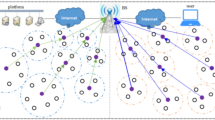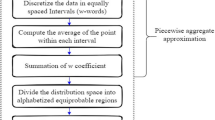Abstract
Wireless Sensor Networks (WSNs) have gained widespread adoption across various applications due to their capacity to collect and wirelessly transmit data. Cognitive Radio (CR) technology presents a promising solution for enhancing spectrum utilization efficiency within WSNs. The fusion of CR with WSNs results in Cognitive Radio Wireless Sensor Networks (CR-WSNs), capable of dynamically selecting optimal spectrum bands for seamless data transmission. However, the operation of CR-WSNs comes with notable energy consumption, and the efficient use of energy is pivotal for prolonging the network's lifespan. This study introduces an energy optimization technique specifically tailored for CR-WSNs, focusing on the crucial aspect of spectrum sensing. The proposed technique deploys a two-stage sensing strategy involving a primary sensor and a secondary sensor. The primary sensor identifies the presence of primary users in the spectrum band, activating the secondary sensor only when a primary user is detected. The secondary sensor conducts more detailed sensing to ascertain the available bandwidth for subsequent data transmission. Machine learning algorithms are employed in the proposed technique to finely tune the energy consumption of the CR-WSN during the spectrum sensing process. Through simulation assessments, the effectiveness of the proposed technique is gauged, revealing significant reductions in the energy consumption of the CR-WSN while upholding a high level of accuracy in spectrum sensing. This technique offers practical applicability in real-world CR-WSN scenarios, contributing to the extension of the network's operational life and enhancement of overall energy efficiency.











Similar content being viewed by others
Data Availability
The data sets generated during and/or analyzed during the current study are available from the corresponding author on reasonable request.
Code Availability
The code is available with corresponding Author.
References
Prashant Mathur, Er., & Kumar, S. (2017). An overview of radio-based cognitive wireless sensor networks a new sensor network paradigm. International Journal on Future Revolution in Computer Science & Communication Engineering, 3(12), 80–84.
Althunibat, S., Di Renzo, M., & Granelli, F. (2015). Towards energy-efficient cooperative spectrum sensing for cognitive radio networks: An overview. Telecommunication Systems, 59, 77–91. https://doi.org/10.1007/s11235-014-9887-2
Gupta, M., & Prakriya, S. (2022). Performance of CSI-based power control and NOMA/OMA switching for uplink underlay networks with imperfect SIC. IEEE Transactions on Cognitive Communications and Networking, 8(4), 1753–1769. https://doi.org/10.1109/TCCN.2022.3185076
Gupta, M., & Prakriya, S. Performance analysis of multiuser uplink underlay NOMA networks. TechRxiv. Preprint. https://doi.org/10.36227/techrxiv.23214296.v1
Rai, S., Gupta. M., & Prakriya, S. (2020). Performance of low-rate NOMA-based uplink underlay networks. In 2020 23rd international symposium on wireless personal multimedia communications (WPMC), Okayama, Japan (pp. 1–6). https://doi.org/10.1109/WPMC50192.2020.9309454
Jayanth, N., Chakraborty, P., Gupta M., & Prakriya, S. (2020). Performance of semi-grant free uplink with non-orthogonal multiple access. In 2020 IEEE 31st annual international symposium on personal, indoor and mobile radio communications, London, UK (pp. 1–6). https://doi.org/10.1109/PIMRC48278.2020.9217246
Pakdel, H., Jahanshahi, M., & Fotohi, R. (2022). An approach to environmental monitoring in sparse linear wireless sensor networks for energy conservation using dual sinks. Wireless Personal Communications, 126, 635–663. https://doi.org/10.1007/s11277-022-09763-2
Wan, X., Chen, Z., Shen, L., & Yang, Z. (2020). Comment on “Improved DV-hop algorithm using locally weighted linear regression in anisotropic wireless sensor networks”. Wireless Personal Communications 114, 1449–1451 https://doi.org/10.1007/s11277-020-07429-5
Njoya, A.N., Ari, A.A.A., Nana Awa, M., Titouna, C., Labraoui, N., Effa, J.Y., Abdou, W., & Gueroui, A. (2020). Hybrid wireless sensors deployment scheme with connectivity and coverage maintaining in wireless sensor networks. Wireless Personal Communications, 112, 1893–1917. https://doi.org/10.1007/s11277-020-07132-5
Keramatpour, A., Nikanjam, A., & Ghaffarian, H. (2017). Deployment of wireless intrusion detection systems to provide the most possible coverage in wireless sensor networks without infrastructures. Wireless Personal Communications, 96, 3965–3978. https://doi.org/10.1007/s11277-017-4363-4
Ding, X. X., Wang, Tt., Chu, H., Liu, X., & Feng, Y. H. (2019). An enhanced cluster head selection of LEACH based on power consumption and density of sensor nodes in wireless sensor networks. Wireless Personal Communications, 109, 2277–2287. https://doi.org/10.1007/s11277-019-06681-8
Mehmood, A., Lv, Z., Lloret, J., & Umar, M. M. (2017). ELDC: An artificial neural network based energy-efficient and robust routing scheme for pollution monitoring in WSNs. IEEE Transactions on Emerging Topics in Computing, 99, 1.
Manjeshwar, A., & Agrawal, D. (2015). TEEN: A routing protocol for enhanced efficiency in wireless sensor networks. In Proceedings of 15th international parallel and distributed processing. Symposium (IPDPS’01) Workshops, USA, California, 2001, (pp. 2009–2015).
Gherbi, C., & Aliouat, Z. (2015). Distributed energy efficient adaptive clustering protocol with data gathering for large-scale wireless sensor networks. In Programming and systems (ISPS), 12th international conference, IEEE, 2015.
Ful, J., Yibing, Z., Yi1, L., Shuo, L., & Jun, P. (2015). The energy efficiency optimization based on dynamic spectrum sensing and nodes scheduling in cognitive radio sensor networks. In 27th Chinese control and decision conference (CCDC), 978-1-4799-7016-2/15/$31.00_c 2015 IEEE.
Alhumud, H., Zohdy, M., Debnath, D., & Olawoyin, R. (2019). Cooperative spectrum sensing for cognitive radio-wireless sensors network based on OR rule decision to enhance energy consumption in greenhouses. Wireless sensor network, 11(01), 1.
Jin, O., Qiao, Y., Liu, A., & Zhang, L. (2018). EESS: An energy-efficient spectrum sensing method by optimizing spectrum sensing node in cognitive radio sensor networks. Wireless Communications and Mobile Computing. https://doi.org/10.1155/2018/9469106
Abdul Gafoor, R., & Kuriakose, R. (2018). Adaptive spectrum sensing in cognitive radio networks. International Journal of Computer Applications, 179(45), 0975–8887.
Raghavendra, Y. M., & Mahadevaswamy, U. B. (2020). Energy efficient routing in wireless sensor network based on composite fuzzy methods. Wireless Personal Communications, 114(2569), 2590. https://doi.org/10.1007/s11277-020-07490-0
Raghavendra, Y. M., & Mahadevaswamy, U. B. (2020). Energy efficient routing in wireless sensor network based on mobile sink guided by stochastic hill climbing. International Journal of Electrical and Computer Engineering (IJECE), 10(6), 5965–5973. https://doi.org/10.11591/ijece.v10i6.pp5965-5973
Raghavendra, Y. M., & Mahadevaswamy, U. B. (2021). Energy efficient intra cluster gateway optimal placement in wireless sensor network. Wireless Personal Communications, 119, 1009–1028. https://doi.org/10.1007/s11277-021-08247-z
Brar, G. S., Rani, S., Song, H., & Ahmed, S. H. (2016). Energy efficient direction-based pdorp routing protocol for WSN. IEEE Special Section on Green Communications and Networking for 5G Wireless, 4, 3182–3194.
Nasser, A., Al Haj Hassan, H., Abou Chaaya, J., Mansour, A., & Yao, K.-C. (2021). Spectrum sensing for cognitive radio: Recent advances and future challenge. Sensors, 21, 2408. https://doi.org/10.3390/s21072408
Bouckaert, S., de Poorter, E., De Mil, P., Moerman, I., & Demeester, P. (2009). Interconnecting wireless sensor and wireless mesh networks: Challenges and strategies. In GLOBECOM 2009–2009 IEEE global telecommunications conference, Honolulu, HI, USA (pp. 1–7). https://doi.org/10.1109/GLOCOM.2009.542586-1
Funding
The authors declare that no funds, grants, or other support were received during the preparation of this manuscript.
Author information
Authors and Affiliations
Contributions
All the authors contributed to prepare the manuscript. Both read and approved the final manuscript.
Corresponding author
Ethics declarations
Competing interests
The authors declare that there are no relevant financial or non-financial competing interests to report.
Ethics approval
The manuscript in part or in full has not been submitted or published anywhere.
Additional information
Publisher's Note
Springer Nature remains neutral with regard to jurisdictional claims in published maps and institutional affiliations.
Rights and permissions
Springer Nature or its licensor (e.g. a society or other partner) holds exclusive rights to this article under a publishing agreement with the author(s) or other rightsholder(s); author self-archiving of the accepted manuscript version of this article is solely governed by the terms of such publishing agreement and applicable law.
About this article
Cite this article
Raghavendra, Y.M., Mahadevaswamy, U.B., Asha, M. et al. Energy Optimization in Spectrum Sensing Using Cognitive Radio Wireless Sensor Networks. Wireless Pers Commun 133, 1675–1691 (2023). https://doi.org/10.1007/s11277-023-10839-w
Accepted:
Published:
Issue Date:
DOI: https://doi.org/10.1007/s11277-023-10839-w




